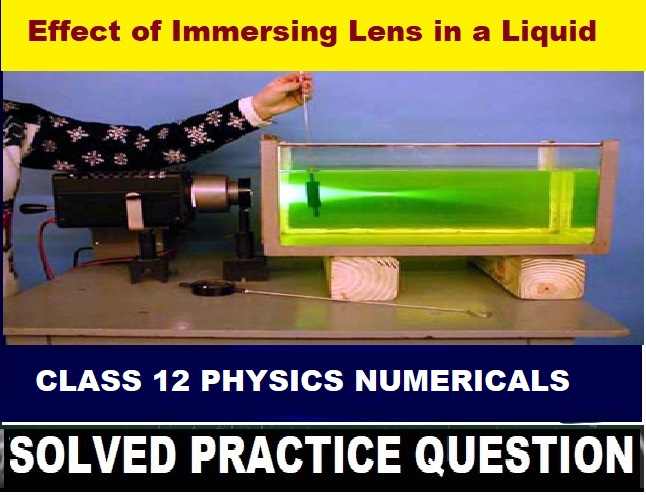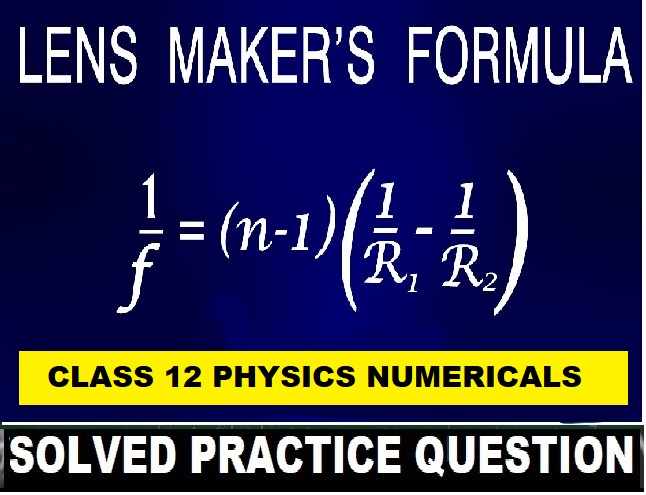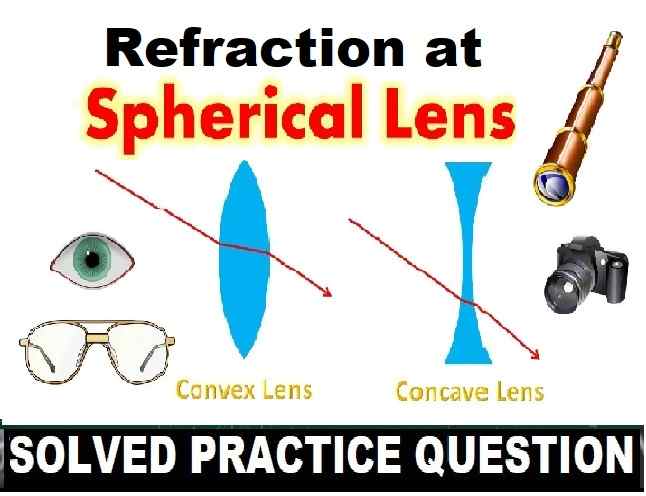Effect of Immersing Lens in a Liquid Numerical Class-12 Nootan ISC Physics Solution Ch-16 Refraction of Light at Spherical Surfaces : Lenses. Step by step solutions of Kumar and Mittal Physics of Nageen Prakashan as council latest prescribe guideline for upcoming exam. Visit official Website CISCE for detail information about ISC Board Class-12 Physics.

Effect of Immersing Lens in a Liquid Numerical Class-12 Nootan ISC Physics Solution Ch-16 Refraction of Light at Spherical Surfaces : Lenses
| Board | ISC |
| Class | 12 |
| Subject | Physics |
| Book | Nootan |
| Chapter-16 | Refraction of Light at Spherical Surfaces : Lenses |
| Topics | Numericals on Effect of Immersing Lens in a Liquid |
| Academic Session | 2025-2026 |
Numericals on Effect of Immersing Lens in a Liquid
Class-12 Nootan ISC Physics Solution Ch-16 Refraction of Light at Spherical Surfaces : Lenses
Que-20. A convex lens has 20 cm focal length in air. What will be its focal length in water?
Ans- fe/fa = aug-1 / (aug/aue)-1
=> fe/20 = 1.5-1 / (1.5/1.33)-1
=> fe = 78.2 cm
Que-21. The refractive index of glass with respect to air is 3/2 and that of water is 4/3. The radii of curvature of a glass convex lens are 20 cm and 30 cm respectively. What will be the focal length of the lens (i) in air, (ii) in water?
Ans- 1/f = (aug – 1) (1/R1 + 1/R2)
=> 1/f = (3/2 – 1) (1/20 + 1/30)
=> f = 24 cm
again fe/fa = aug-1 / (aug/aue)-1
=> fe/24 = (3/2)-1 / (3/2 x 3/4)-1
=> fe = 96 cm
Que-22. The focal length of a convex lens of glass (n = 1.50) in air is 40 cm. Calculate the focal length of the lens when it is immersed in a liquid of refractive index (i) 1.30, (ii) 1.50, (iii) 1.70.
Ans-(i) fe/fa = aug-1 / (aug/aue)-1
=> fe/40 = 1.5-1 / (1.5/1.3)-1
=> fe = 130 cm
(ii) fe/fa = 1.5-1 / 1-1
=> fe = ∞
(iii) fe/fa = 1.5-1 / (1.5/1.7)-1
=> fe = -170 cm
Que-23. The radii of curvature for spherical surfaces of a bi-convex lens are 20 cm and 30 cm. The refractive index of the material of the lens with respect to air is 1.5. If the lens is dipped in a liquid of refractive index 1.65 with respect to air, calculate its effective focal length and state the nature of the lens.
Ans- 1/f = (1μ2 – 1) (1/R1 + 1/R2)
=> 1/f = (1.5 – 1) (1/20 + 1/30)
=> f = 24 cm
again fe/fa = aug-1 / (aug/aue)-1
=> fe/24 = 1.5-1 / (1.5/1.65)-1
=> fe = -132 cm
— : End of Effect of Immersing Lens in a Liquid Numerical Class-12 Nootan ISC Physics Solution Ch-16 :–
Return to : – Nootan Solutions for ISC Class-12 Physics
Thanks
Please share with your friends


